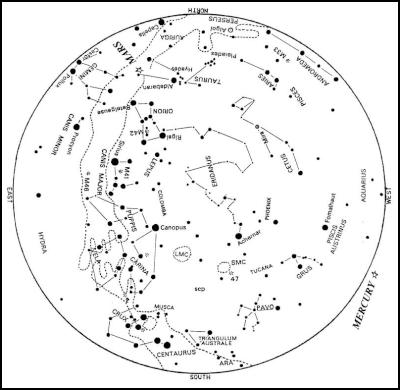Brian Carter: The January Night Sky
Brian Carter
The Carter Observatory wishes
you all a wonderful holiday over the Christmas break and
hope that 2008 is good to you all.
The January Night Sky
Towards the end of the month we will start to see the days getting shorter and, therefore, the nights for astronomy longer.
Planets
January
is a fair month for viewing the planets. Mars, Saturn
and Venus are visible all month. Jupiter will be visible in
the morning sky for all but the start of the month. Mercury
may just be visible in the evening twilight around the
middle of the month.
Mars will be
visible for the first three quarters of the night. At the
start of the month it sets at 05 00 and at 02 37 by
month’s end. Mars is in the constellation of Taurus. At
the beginning of January its magnitude is –1.5, (it’s
brightest for the year), and fades to –0.6 by the end of
the month.
Mercury may just be visible
in the evening twilight around the middle of January. By
January 14 it sets at 21 54, which is 59 minutes after the
Sun. Mercury starts the month in the constellation of
Sagittarius, moving into Capricornus on January 9. On
January 14 its magnitude is
–0.8.
Saturn is visible for the last
three quarters of the night. It rises at 23 54 at the start
of January and at 21 53 by month’s end. Saturn is in the
constellation of Leo, in which it remains until September
2009. Its magnitude slightly brightens from 0.6 to 0.4
during the month.
Venus will be visible
in the Eastern morning twilight sky. At the beginning of
January it rises at 03 29 and at 03 49 by month’s end.
Venus starts the month in the constellation of Libra, moving
into Scorpius on January 3, into Ophiuchus on January 7 and
finally into Sagittarius on January 22. Venus slightly fades
from –4.1 to –4.0 during
January.
Jupiter will be visible in the
morning twilight for all but the start of January. At the
start of the month it rises at 05 23, only 28 minutes before
Sunrise and at 03 55 by month’s end. Jupiter is in the
constellation of Sagittarius, in which it remains until
January 2009. Its magnitude slightly brightens from –1.8
to –1.9 during the month.
All times are for
Wellington unless otherwise stated. Other centres may vary
by a few minutes.
Phases of the
Moon
New Moon – January 9 at 00 37.
First Quarter
– January 16 at 08 46.
Full Moon – January 23 at 02
35.
Last Quarter – January 30 at 18 03.
Earth
at Perihelion on January 3
The Earth is at perihelion (closest to the Sun) at 13 00 on January 3. The distance is 0.9832801 AU, which is 147,096,600 km.
THIS MONTH’S SKY CHART
This chart shows the sky as it appears at about 22 00 for ~January 15.

Click for big version
How To Use the Sky
Charts
To use the sky chart hold it up to the sky so
that the direction in which you are looking is at the lower
edge of the map. For example, if you are looking at the
western horizon then the map should be held so that the
“WEST” label is at the lower edge. The altitude and
direction of the stars and planets will then be correctly
shown. The centre of the chart will be directly
overhead.
If you would like to receive Carter Observatory’s full e-Newsletter, please email to Astronomy@carterobservatory.org to be included on the list.
Brian Carter is the Senior Astronomer at Carter Observatory (The National Observatory of New Zealand), PO Box 2909, Wellington. (DDI; 04 920 9252, Email: Brian.Carter@carterobservatory.org , Observatory Web Site: www.CarterObservatory.org


 John Mazenier: Gaffer Tape And Glue Delivering New Zealand’s Mission Critical Services
John Mazenier: Gaffer Tape And Glue Delivering New Zealand’s Mission Critical Services Earthquake Commission: Ivan Skinner Award Winner Inspired By Real-life Earthquake Experience
Earthquake Commission: Ivan Skinner Award Winner Inspired By Real-life Earthquake Experience Reserve Bank: Consultation Opens On A Digital Currency For New Zealand
Reserve Bank: Consultation Opens On A Digital Currency For New Zealand NIWA: Ship Anchors May Cause Extensive And Long-lasting Damage To The Seafloor, According To New Research
NIWA: Ship Anchors May Cause Extensive And Long-lasting Damage To The Seafloor, According To New Research New Zealand Customs Service: A Step Forward For Simpler Trade Between New Zealand And Singapore
New Zealand Customs Service: A Step Forward For Simpler Trade Between New Zealand And Singapore Horizon Research: 68% Say Make Banks Offer Fraud Protection
Horizon Research: 68% Say Make Banks Offer Fraud Protection



